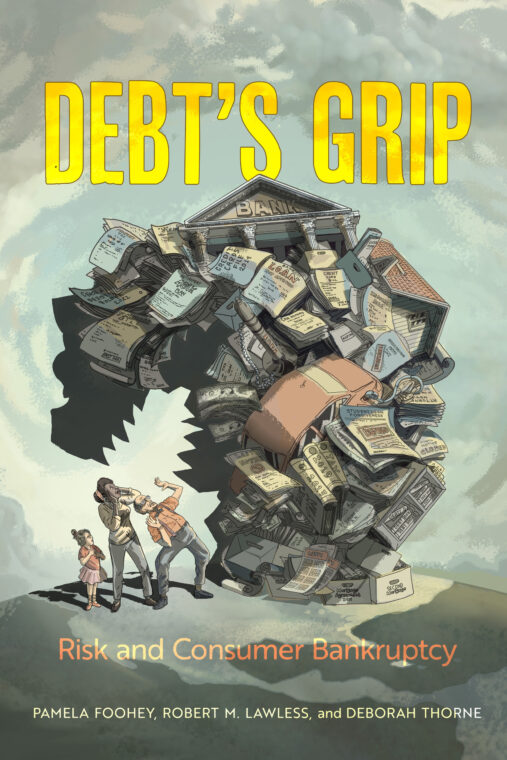A new book co-written by a University of Illinois Urbana-Champaign law professor and nationally recognized expert in bankruptcy law and consumer finance explores both the stories and the data behind people who file for bankruptcy in the U.S.
"Debt's Grip: Risk and Consumer Bankruptcy" was published by the University of California Press and shows "what it means to live in a state of financial precarity, where household finances are fragile, and where one small expense can blow up everything," said Robert M. Lawless, the Max L. Rowe Professor of Law and co-director of the Illinois Program on Law, Behavior and Social Science at Illinois.
Lawless's co-authors are Pamela Foohey, the Allen Post Professor of Law at the University of Georgia School of Law, and Deborah Thorne, a professor of sociology at the University of Idaho.
"When we thought about writing this book, we asked ourselves, 'What do we have from the data that we think people would want to read?'" Lawless said. "We also wanted to write a book that had a broader reach, so we realized that we had to show both the data and the personal stories of the people who show up in bankruptcy court."
The book draws on 11 years of data from the Consumer Bankruptcy Project and uses the stories of bankruptcy filers to elaborate on several themes, Lawless said.
"There are many roads to bankruptcy in the U.S., so we began by exploring some of them, which we tried to do in a nontechnical way that's accessible to nonacademic readers," he said.

The book also explores the different kind of the debts that people have - medical debts, credit card debt, student loans, cars, mortgages, to name a few - as well as the emerging demographic trends in bankruptcy.
"Women are overrepresented in bankruptcy, especially single women with children, compared to their percentage of the population," Lawless said. "Blacks are also overrepresented. And one of the reasons why is the simple fact that what happens in the rest of society comes into bankruptcy court, including gender and racial wealth inequality."
Health problems and medical debt remain some of the biggest factors when filing for bankruptcy, according to the book.
"People mistakenly thought that the Affordable Care Act would erase the problem of medical debt, and it has certainly helped it, but it didn't fix it, nor was it intended to," Lawless said. "A compounding factor is that fewer jobs now come with high-quality health care benefits for employees. Also, the trend over the last decade has turned workers into independent contractors in the gig economy, and those jobs usually don't come with benefits.
"So the Affordable Care Act is there as a last resort, but it still sticks people with co-pays and other expenses. And if you're sick, you can't work, which means money's not coming in. The bills start piling up, and there's nothing that solves that problem when the rent is due and there needs to be food on the table."
The next step can sometimes entail seeking nontraditional forms of credit such as payday lenders, "and those tend to be very expensive," Lawless said.
"But if you have a choice between keeping the heat on or not, or buying groceries for your kids or not, then going to the payday lender may be a rational choice," he said. "An expensive and potentially financially ruinous decision, but it just underscores the shift in societal risk from 'We're all in this together' to 'You're on your own.' Again, it speaks to the precariousness of where we are right now."
In any given year, there's around 1 million people filing for bankruptcy in the U.S., according to the book.
"That's a running average over the last decade," Lawless said. "Some years it's more, some years it's less. Around one of every 11 people in the U.S. uses the bankruptcy system during their lifetime. If you have a large extended family, that could very well be someone you know, although it's certainly not something that people like to publicize. There's still very much a social stigma around bankruptcy."
The fastest growing demographic group of bankruptcy filers are people over the age of 65.
"That was not true 30 years ago, and you can chalk it up to people's retirement income being less secure, with fewer pensions and more defined contribution benefit plans such as 401(k)s," Lawless said. "There's also an increasing number of older Americans with student loan debts because they're often co-signing loans for other family members."
If you're younger and file for bankruptcy, "there's a chance to rebuild your income and savings," he said. "If you're older, you don't have that same opportunity. You also have fewer opportunities for earning new income. It's a real challenge. But the idea of bankruptcy itself remains stigmatized, leading people to deplete their retirement nest eggs to pay creditors. When, in reality, most retirement savings accounts are protected from creditors. People deplete them because of the perceived stain of bankruptcy, and because they don't know any better. And by the time they consult with a bankruptcy attorney, they've drained their accounts and it's often too late."






